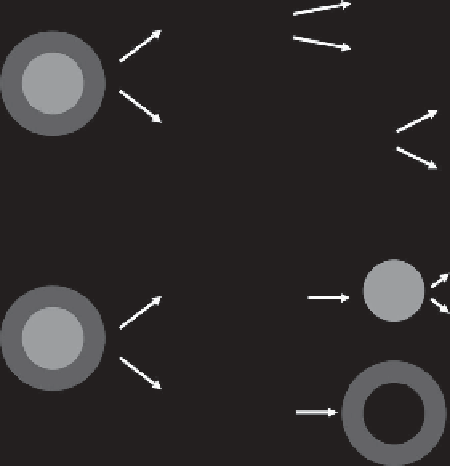Biomedical Engineering Reference
In-Depth Information
Composition of the nanoparticles
Elemental analysis (C, H, O, N)
Composition
1
H NMR in DMSO
Insoluble/soluble ratio
Presence of homopolymer
Extraction of soluble fraction in
THF
Lyophilized
nanoparticles
Mw of soluble fraction
(SEC, MALDI-TOF)
Composition and structure of the copolymer
Mw of the polymer
(SEC)
Composition
1
H NMR in DMSO
Acid hydrolysis
Basic hydrolysis
NaOH, NaH
Composition
1
H NMR in D
2
O
Lyophilized
nanoparticles
FIGURE 18.3
A scheme explaining the strategy developed to analyze the composition and the structure of
copolymers composing polysaccharide-coated PACA nanoparticles.
This difference in the structure of the copolymer generates a fundamental difference in the
characteristics of the nanoparticle corona, considering that the polysaccharide part of the copoly-
mer is anchored in the core of the nanoparticles, thanks to the contribution of the PACA segments.
Consequently, the number of PACA segments attached to the polysaccharide determines its spatial
arrangement in the nanoparticle corona and its freedom to move (Table 18.1) (Chauvierre et al., 2004;
Bertholon et al., 2006c). Simulations of the coronal structure of a few polysaccharide-coated PACA
nanoparticles could be suggested. Models showing the configuration of polysaccharide chains in
nanoparticle coronae could be drawn from the structure of the copolymers (Bertholon et al., 2006b;
Zandanel and Vauthier 2012). Improved simulations were carried out from the copolymer's com-
position in polysaccharide and PACA, the structure of the copolymer, the diameter of the core of
the nanoparticles, and their hydrodynamic diameter. Models drawn from the improved simulations
can provide with information about the density of the polysaccharide chains within the nanoparticle
corona (Vauthier et al., 2009, 2011). Table 18.2 summarizes the models established from the deep
characterization of several PACA nanoparticles coated with dextran, which were then used to inves-
tigate their interactions with proteins.
18.3 INTERACTIONS OF POLYSACCHARIDE-COATED NANOPARTICLES
WITH PROTEINS
When nanoparticles or, more generally, drug carrier nanotechnologies, are injected in the blood,
proteins immediately interact with the foreign particles. At first, interactions consist of the adsorp-
tion or deposition of proteins on the material's surface. During this event, the particle's surface is
decorated with blood proteins. The layer of proteins formed gives a “biological identity” to the
nanoparticles that plays a fundamental role in subsequent events (Vonarbourg et al., 2006; Nilsson
et al., 2007; Alexis et al., 2008; Dobrovolskaia et al., 2008). For instance, the nanoparticle surface's
access to certain proteins can trigger the activation of the immune systems. When the immune
system is activated, the particle is rapidly taken up by macrophages, in charge of the elimination of

